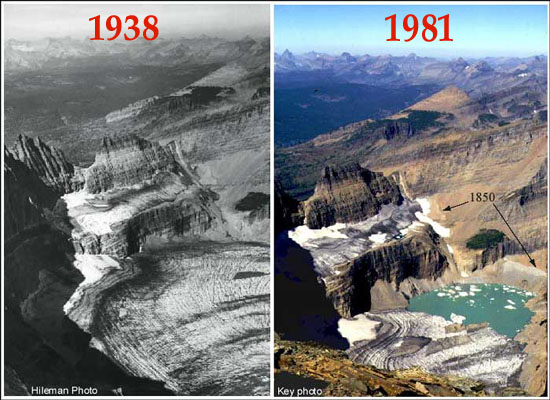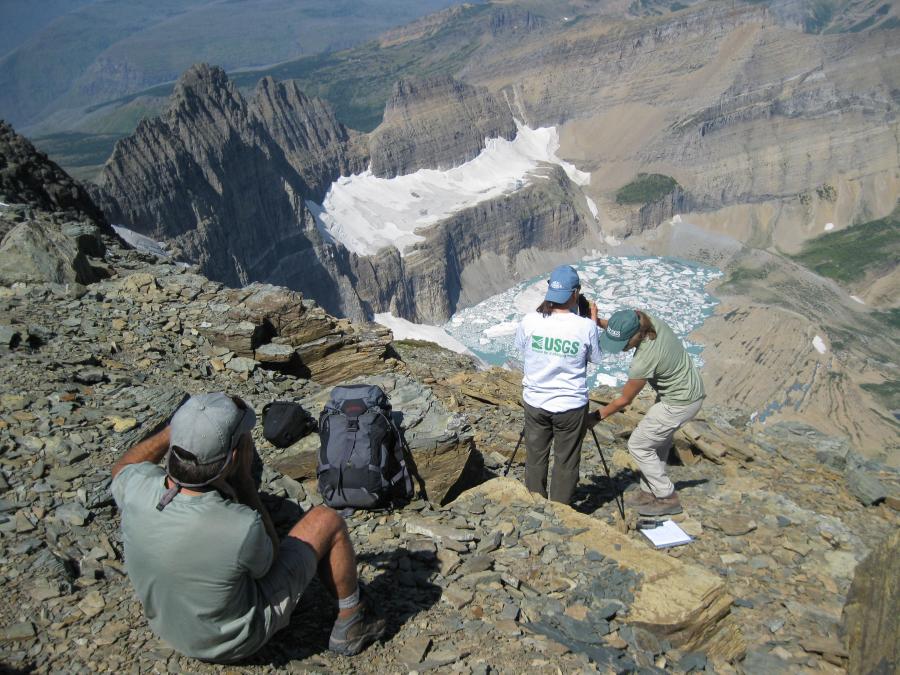|
Meltdown in
Glacier National Park 
Grinnell Glacier: Photos
courtesy of the USGS The
photos of Grinnell Glacier illustrate the toll that
global warming has taken on the glaciers in
Glacier National Park. Of the 150 glaciers that
were present in 1850, only 35 remain today.
According to a team of U.S.G.S. scientists, the
glaciers will melted completely within 30
years. The same trend has been observed
throughout the world. The snows of Mount
Kilamanjaro are disappearing, as are the
Himalayan glaciers. Experts fear that glaciers
in the Andes and the Swiss Alps will suffer the
same fate within decades. There is no longer
any debate among scientists that the world is
getting warmer. Nor is there much doubt that
the current rate of warming is faster than any
other time over the past 10,000 years. In fact,
eight of the ten hottest years have occurred
since 1990.
What's causing this "global
warming"?
Most climate scientists think that the burning
of fossil fuels (coal, oil, natural gas) has
contributed to the warming trend. Whenever
we burn coal to generate electricity, burn
natural gas to heat our homes and water, or
burn gasoline to run our trains, planes, and
automobiles, carbon dioxide is released into
the atmosphere. Carbon dioxide is a
"greenhouse gas". Like car windows on a
sunny day, carbon dioxide lets sunlight pass
through. Light rays that strikes dark surfaces
are absorbed and changed into heat. Then,
as this heat is given off as infrared waves,
both the glass in the car and the carbon
dioxide in our atmosphere absorb these
longer waves, "trapping" the heat. Although
not everyone agrees with this theory, the vast
majority of scientists do believe that an
increased "greenhouse effect" is at least partly
responsible for the global
warming.
Not the first time the glaciers have melted away . . .
Contrary to popular belief, the glaciers in Glacier Park are NOT remnants of the last ice age, which ended roughly 10,000 years ago. There is little doubt that ice age glaciers WERE responsible for carving the majestic peaks and valleys of the park (horns, cirques, aretes, hanging valleys, etc.), but experts believe those glaciers completely melted away during an especially warm period 9,000 to 5,000 years ago (known as the altithermal or Holocene Climate Maximum). On the other hand, glaciers present in the park today formed during a more recent cold period called "The Little Ice Age" (not a true "ice age") - a cold period that lasted from 1550 to 1850. According to evidence from moraines, tree rings, layers of volcanic ash, and radiometric dating, these "Little Ice Age glaciers" formed in cirques that were carved by glaciers during the last real ice age(s). The photo in the upper right of this page shows an end moraine that marks the extent of the Grinnell Glacier during the Little Ice Age (another photo). That same moraine can be seen on the photo below. If you don't believe glaciers can form so quickly, check out this article and photo of "Crater Glacier", which formed in the crater of Mt. St. Helens since its explosive eruption in 1980.
 Above: Lisa McKeon and Lindsey Bengtson photograph Grinnell Glacier from the summit of Mount Gould in August of 2009. CLICK HERE to see their photo. Courtesy of the USGS
Term: greenhouse gas
|



